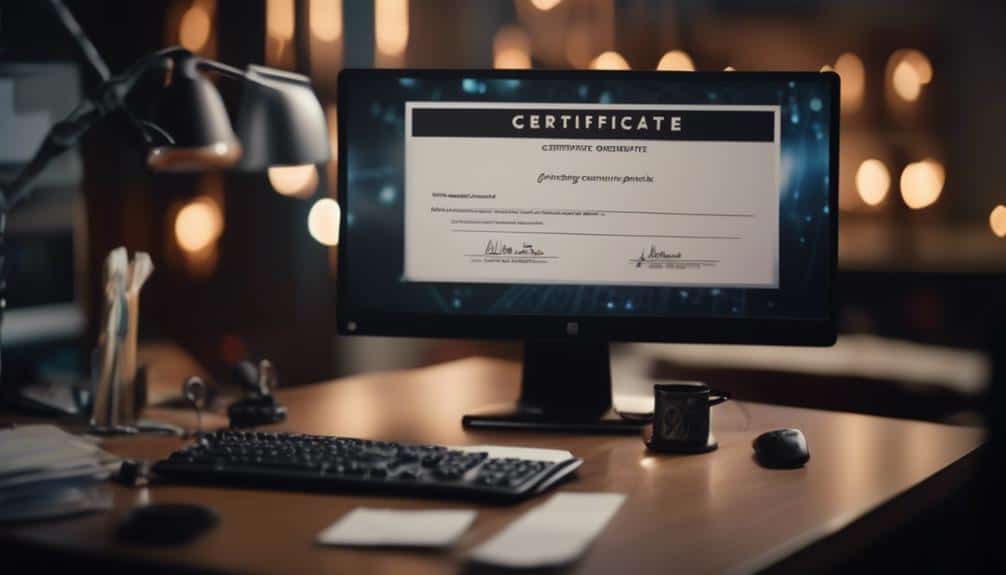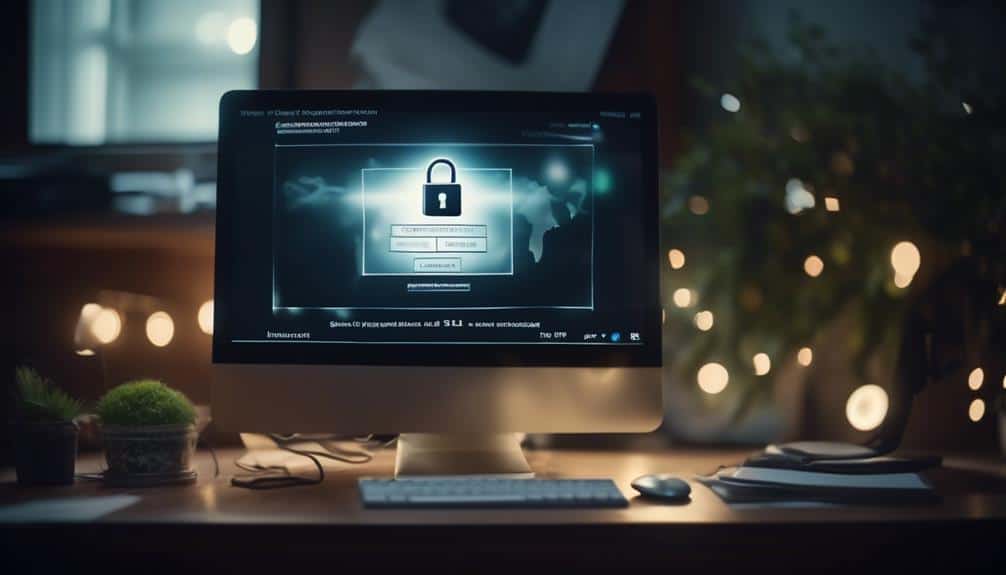Avoiding Common Pitfalls in SSL Certificate Installation
Imagine you're building a house, carefully selecting each brick and measuring every angle. You take pride in your work, ensuring that every detail is perfect. But then, when it comes time to install the roof, you overlook a small step – a missing nail here, a loose shingle there.
Suddenly, your once sturdy house becomes vulnerable to leaks and damage. Just like a poorly installed roof can compromise the integrity of a house, improper SSL certificate installation can leave your website exposed to security risks.
In this discussion, we will explore the common pitfalls that many encounter when installing SSL certificates and provide you with practical tips to avoid them. So, before you expose your online presence to potential vulnerabilities, let's take a closer look at how to ensure a secure and seamless SSL certificate installation.
Key Takeaways
- Choose the right type of SSL certificate based on the level of trust and security required, as well as the size and nature of the business.
- Follow the instructions provided by the SSL certificate provider for domain ownership verification, which can involve DNS record, file-based authentication, or email-based verification.
- Generate and submit a CSR (Certificate Signing Request) containing accurate and up-to-date information to the chosen certificate authority (CA) for verification before obtaining the SSL certificate.
- Properly configure SSL/TLS on the server by implementing server hardening measures, choosing strong cipher suites, enabling Perfect Forward Secrecy (PFS), regularly patching and updating server software, and staying up-to-date with the latest security recommendations.
Choosing the Right SSL Certificate

To ensure the security and trustworthiness of your website, it's crucial to carefully select the appropriate SSL certificate. Choosing the right SSL certificate for e-commerce websites requires understanding the different types of SSL certificates available.
There are three main types: domain validated (DV), organization validated (OV), and extended validation (EV).
Domain validated (DV) certificates are the most basic type and are suitable for small e-commerce websites. They only verify the ownership of the domain and provide basic encryption.
Organization validated (OV) certificates offer a higher level of assurance as they require businesses to provide additional documentation to prove their identity. This type of certificate is ideal for medium-sized e-commerce websites that handle sensitive customer information.
Extended validation (EV) certificates provide the highest level of trust and security. They require a thorough verification process, including legal and operational checks. EV certificates display a green address bar in the browser, indicating a trusted and secure connection. This type of certificate is recommended for large e-commerce websites that process a significant volume of transactions.
When choosing the right SSL certificate for your e-commerce website, consider the level of trust and security required, as well as the size and nature of your business. By selecting the appropriate SSL certificate, you can ensure the protection of your customers' sensitive information and establish a secure online shopping environment.
Verifying Domain Ownership
When verifying domain ownership for your SSL certificate, it's important to follow a thorough and precise process to ensure the security and trustworthiness of your website.
There are two common methods to verify domain ownership:
- Verifying domain ownership through DNS records: This method involves adding a specific DNS record to your domain's DNS configuration. The SSL certificate provider will provide you with the necessary information, such as the record type and value, which you need to add to your DNS settings. This process allows the provider to validate that you have control over the domain.
- Verifying domain ownership through file-based authentication: In this method, the SSL certificate provider will ask you to upload a specific file to your website's root directory. The provider will provide you with the file and its location. Once the file is uploaded, the provider will check if it's accessible via a specific URL. This method is commonly used when DNS record modification isn't feasible or when you need a quicker verification process.
- Verifying domain ownership through email: Some SSL certificate providers may also offer email-based verification. They'll send an email to a specific email address associated with the domain. You'd need to follow the instructions in the email to verify domain ownership.
Generating and Submitting a Certificate Signing Request (CSR)

You can generate and submit a Certificate Signing Request (CSR) to obtain an SSL certificate for your website.
A CSR is a file that contains information about your website and is used by the Certificate Authority (CA) to generate a unique SSL certificate for your domain.
To generate a CSR, you'll need to follow a few steps:
- Generate a private key: This is a crucial step as the private key is used to encrypt and decrypt data sent between your website and the user's browser. Keep this key secure and never share it with anyone.
- Fill in the CSR form: This form contains information such as your domain name, organization name, and location. Make sure to provide accurate and up-to-date information to avoid any delays or errors during the certificate issuance process.
- Submit the CSR to the CA: Once you have generated the CSR, you'll need to submit it to your chosen CA. The CA will verify the information provided in the CSR and issue the SSL certificate if everything checks out.
Understanding the role of the certificate authority in the CSR process is essential. The CA is responsible for verifying your domain ownership and ensuring that the information provided in the CSR is accurate. They play a crucial role in validating your website's identity and issuing the SSL certificate.
Troubleshooting common CSR errors can be challenging, but by double-checking the information provided in the CSR and following the CA's guidelines, you can avoid any potential issues.
Configuring SSL/TLS on the Server
Now that you have obtained your SSL certificate, it's important to properly configure SSL/TLS on your server to ensure secure and reliable communication.
To help you with this process, there are several server configuration best practices you should follow.
Additionally, implementing certain SSL/TLS tips can further enhance the security and performance of your website or application.
Server Configuration Best Practices
To ensure secure communication between the server and clients, it's crucial to configure SSL/TLS properly on the server. Here are three server configuration best practices for a secure socket layer (SSL) setup:
- Implement Server Hardening Measures: Strengthen your server's security by applying server hardening techniques such as disabling unnecessary services, minimizing user privileges, and regularly patching and updating your server software. This reduces the attack surface and enhances overall server security.
- Choose Strong SSL/TLS Cipher Suites: Selecting secure and robust cipher suites ensures that the encryption protocols used for SSL/TLS communication are strong and resistant to attacks. Disable outdated and weak cipher suites, and prioritize the use of modern, secure ones.
- Enable Perfect Forward Secrecy (PFS): PFS ensures that even if the private key of an SSL/TLS certificate is compromised, previously intercepted communications can't be decrypted. Enabling PFS adds an extra layer of security to your SSL/TLS configuration.
SSL/TLS Implementation Tips
Implementing SSL/TLS on the server requires careful configuration to ensure a secure and reliable communication channel. To avoid ssl/tls troubleshooting and common certificate errors, follow these implementation tips:
- Choose a strong cryptographic algorithm: Select a cipher suite that offers a high level of security and compatibility with client browsers.
- Use a trusted certificate authority: Obtain an SSL/TLS certificate from a reputable CA to ensure that your certificate is trusted by all major browsers.
- Verify certificate installation: Double-check that the certificate is correctly installed on the server and that the private key is securely stored.
- Implement proper certificate validation: Enable certificate revocation checks to ensure that the certificate hasn't been revoked by the CA.
- Regularly update SSL/TLS configuration: Stay up-to-date with the latest security recommendations and patch any vulnerabilities in the SSL/TLS implementation.
Installing the SSL Certificate

Now that you have successfully configured SSL/TLS on your server, the next step is to install the SSL certificate.
This involves two main tasks: key generation and certificate installation.
During key generation, a public-private key pair is created, which is essential for secure communication.
Once the key pair is generated, the SSL certificate needs to be installed on the server to enable encrypted connections.
Key Generation
You can start the process of installing the SSL certificate by generating the key. This step is crucial for securing your website and ensuring the confidentiality of sensitive information.
Here are three key points to keep in mind during the key generation process:
- Troubleshooting key generation issues:
Sometimes, you may encounter difficulties in generating the key. This could be due to incorrect configurations or compatibility issues with your server software. It's essential to carefully follow the instructions provided by your certificate authority and consult their support if you encounter any problems.
- Importance of keeping private keys secure:
Private keys are the foundation of SSL certificates and must be kept confidential. If someone gains access to your private key, they can impersonate your website or decrypt encrypted data. Therefore, it's crucial to store your private key in a secure location and implement appropriate access controls to prevent unauthorized access.
- Regularly updating your keys:
As a best practice, it's recommended to periodically update your SSL certificate and generate new keys. This helps ensure the highest level of security and reduces the risk of potential vulnerabilities being exploited.
Certificate Installation
To successfully install an SSL certificate, follow these steps carefully.
Common mistakes in certificate installation can lead to security vulnerabilities and compatibility issues.
First, make sure to choose the correct server software and version for your SSL certificate.
Next, ensure that you have the necessary administrative access to install the certificate.
When installing the certificate, double-check that you're using the correct file format and that the private key matches the certificate.
Troubleshooting certificate installation issues may involve checking for potential conflicts with existing certificates or resolving issues with the server configuration.
It's important to carefully review error messages and consult the certificate authority's documentation or support for guidance.
Updating Internal Links and Resources
Consider updating internal links and resources to ensure that they're utilizing the new SSL certificate. Updating outdated links is crucial for maintaining a secure and seamless user experience on your website.
Here are three important steps to help you troubleshoot broken links and update them effectively:
- Identify outdated links: Conduct a thorough audit of your website to identify any links that still use the old HTTP protocol instead of HTTPS. This can be done manually or by using tools like Screaming Frog or Google Search Console.
- Update internal links: Once you have identified the outdated links, update them to use the new SSL certificate by changing the URL from HTTP to HTTPS. This ensures that visitors are securely redirected to the correct pages.
- Check external resources: Don't forget to update any external resources, such as images, scripts, or stylesheets, that may be linked to your website. Make sure these resources are also using HTTPS to prevent mixed content warnings and maintain a secure browsing experience.
Testing SSL Configuration

After updating internal links and resources, the next step is to test the SSL configuration to ensure that it's properly installed and functioning correctly. Testing the SSL configuration is crucial before deploying it to ensure the security and reliability of your website or application.
Common mistakes in SSL certificate testing can lead to vulnerabilities and compromise the security of your system. One common mistake isn't checking for certificate expiration dates. It's important to regularly check and renew SSL certificates to avoid any interruptions in the secure connection.
Another common mistake isn't configuring the SSL certificate properly. This can result in SSL errors or warnings being displayed to users, which can negatively impact their trust in your website or application.
Testing the SSL configuration before deployment is of utmost importance. It helps identify any issues or misconfigurations that may exist, allowing you to fix them before they become a problem. It ensures that the SSL certificate is correctly installed and that all connections are secure.
Regularly Renewing and Updating SSL Certificates
Regularly updating and renewing SSL certificates is essential for maintaining the security and reliability of your website or application. By doing so, you can prevent potential security vulnerabilities and ensure that your site remains trusted and protected.
Here are three reasons why regularly renewing and updating SSL certificates is crucial:
- Importance of SSL certificate expiration reminders: SSL certificates have an expiration date, and failing to renew them in a timely manner can result in your website or application becoming inaccessible or displaying security warnings to users. By setting up expiration reminders, you can stay proactive and ensure that you renew your certificates before they expire.
- Impact of outdated SSL certificates on website security: Outdated SSL certificates pose a significant risk to your website's security. Cybercriminals can exploit vulnerabilities in expired or outdated certificates to intercept sensitive user data, launch phishing attacks, or inject malicious code into your site. Regularly updating your certificates helps protect against these threats and keeps your users' information secure.
- Maintaining customer trust and credibility: SSL certificates are a signal to users that your website is secure and trustworthy. If your certificates are outdated or expired, visitors may become wary of sharing their personal information or making transactions on your site. By regularly renewing and updating your SSL certificates, you demonstrate your commitment to security and maintain the trust of your customers.
Frequently Asked Questions
What Are the Consequences of Not Properly Installing an SSL Certificate?
If you don't properly install an SSL certificate, the consequences can be severe. Your website may become vulnerable to attacks, browser warnings may scare away visitors, and your reputation and customer trust could suffer.
How Do I Know if My SSL Certificate Is Compatible With All Major Web Browsers?
To ensure cross browser compatibility with your SSL certificate, you should conduct SSL certificate compatibility testing. This will help you determine if your certificate works properly on all major web browsers.
Can I Use the Same SSL Certificate for Multiple Domains or Subdomains?
Yes, you can use the same SSL certificate for multiple domains or subdomains by using wildcard SSL certificates. Make sure to follow the proper installation process on different web servers for each domain or subdomain.
What Should I Do if I Encounter Errors or Warnings During the SSL Certificate Installation Process?
If you encounter errors or warnings during SSL certificate installation, troubleshoot the issue by checking DNS settings, verifying the certificate chain, and ensuring the correct installation process. Seek help from your certificate provider if needed.
Are There Any Specific Security Measures I Should Take After Installing an SSL Certificate to Ensure the Ongoing Protection of My Website?
To ensure ongoing security of your website after installing an SSL certificate, follow best practices such as regularly updating your certificate, enabling HSTS, implementing secure coding practices, and conducting regular security audits.
Conclusion
In conclusion, avoiding common pitfalls in SSL certificate installation is crucial for maintaining a secure and trustworthy website. By choosing the right SSL certificate, verifying domain ownership, generating and submitting a CSR, configuring SSL/TLS on the server, installing the certificate, updating internal links and resources, testing the SSL configuration, and regularly renewing and updating SSL certificates, website owners can ensure the protection of sensitive data and establish a strong online presence.
It's essential to follow these steps diligently to prevent any potential vulnerabilities or security breaches.








